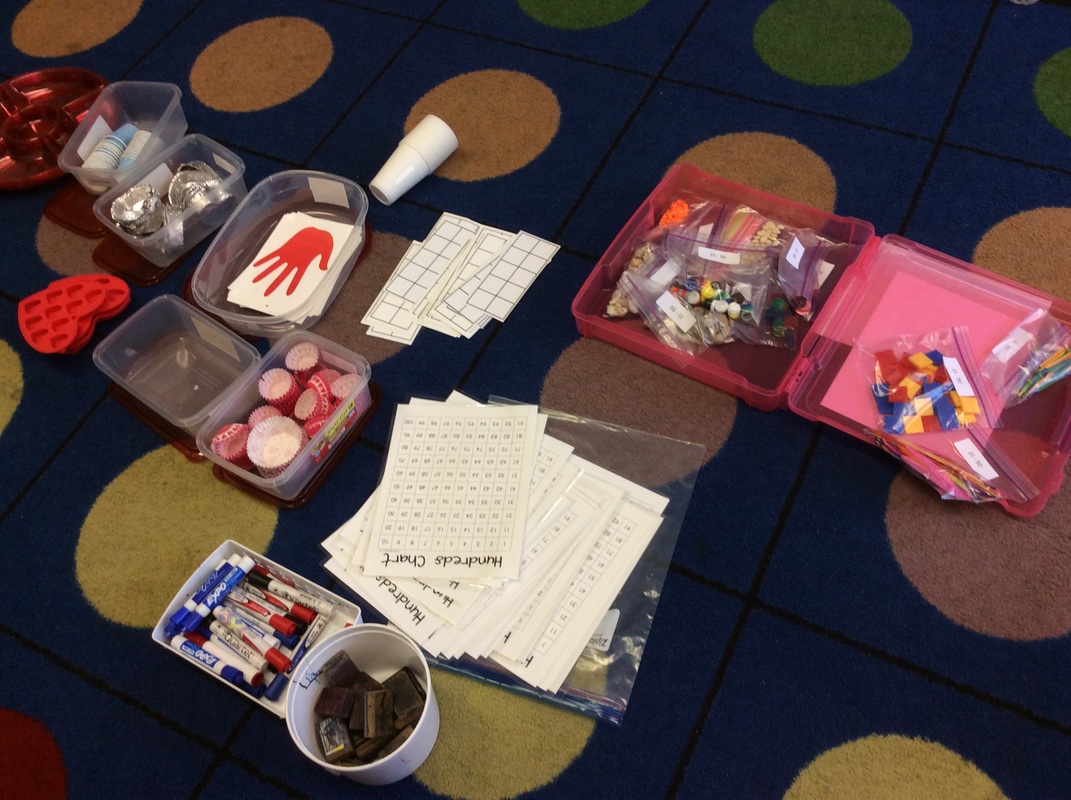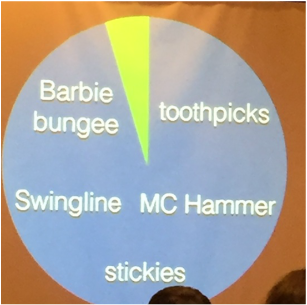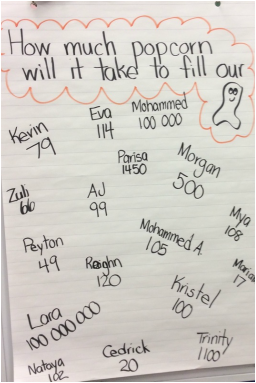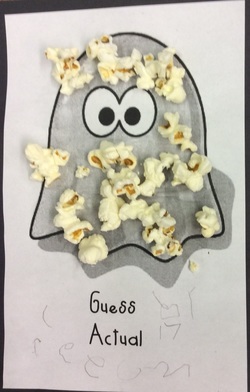 Today I had the pleasure of working with a lovely Kindergarten class at Jessie Lee Elementary to introduce Counting Collections. I began by reading aloud the book If A Chicken Stayed for Supper by Carrie Weston. In this delightful tale, five little foxes sneak out of their den, despite being told by their mother to stay home while she goes out looking for dinner. While out playing, the foxes begin to worry that perhaps one of them may get lost in the dark. The eldest fox, Tufty, decides she will take charge and count her brothers and sisters. She taps each fox on their nose but forgets to count herself and mistakenly thinks they have lost someone. All of the foxes begin to cry. Next, the second eldest fox, Mufty, tries his best to count, pulling each fox's tail but again he forgets to count himself and ends up with a count of four. Again, the foxes think they are one short. In the end Mother Hen comes to the rescue and lines up all the foxes and taps each one on their head. The foxes yap with joy! "You've found one of us! Thank you! Thank You!" I use this engaging story to springboard children's ideas about strategies they can use to keep track of quantities when counting. We discuss, what different ways did the foxes and Mother Hen use to help keep track? How do you keep track? To assist the students with one-to-one correspondence, we provided five and ten frames, as well as small soup cups for the students to use should they wish to. We explored how these 'tools' help us to organize our items and potentially see groups of items. For many students, having cups available to place one counting collection item in at a time, helped them to keep track. Sometimes at this age children will skip an item when counting or count the same item twice. Additionally, not all children have a solid understanding of the stable order of the numbers (e.g., they might say "one, two, three, five"... skipping four). Counting collections provides a wonderful opportunity for one-to-one correspondence, learning the correct of numbers, and cardinality (knowing the last number you say represents the total amount of the set) . For more information about Counting Collections, please check this blogpost and under the Ideas section - Counting Collections. Sept 29th update: An important point another Numeracy Teacher (thank you Janice) reminded me of, is the focus on working with partners in September. Counting Collections is something we do with others. In the K class on Wednesday we discussed how we work with partners. How do we respond to a partner when we hear there name called with ours? We modelled some positive options, including giving a "high five" and saying "I'm happy to be your partner". In a respectful classroom community, students need to understand that they will be required to work with others in friendly ways. We included the students in helping us to determine how to work out who chooses the counting collection bag and who chooses the tools. On this day, it was determined that the taller partner would choose the collections. We also modelled how to help each other to organize the collections and take turns counting. I've also had some questions about the yellow stickies. I've always had stickies and markers available in my tool kits for students who wish to record their estimate and/or to record their actual count. At this point in the year in Kindergarten, many students are just learning how to form numerals, so writing the numerals should NOT be a requirement. The stickies are there if students wish to use them, but many won't and this is fine. In reflection, I think I would take the stickies and markers out of my tools bin when working with Kindergarten students for the first several months, as writing numerals is not one of the learning intentions of this activity. If teachers were wondering whether their students could match a quantity to a numeral, there are many other, more engaging ways to do this (e.g., build a set, roll and make the matching playdough number)
1 Comment
 It has now been eight months since I began my position as an Early Numeracy Teacher in Surrey. My learning curve has been steep this year and I have loved every minute of it. I am trying new things and constantly reflecting and deepening my understanding of how children develop number sense. This learning brought me a renewed energy and passion for teaching. One of the many activities I have been working with this year, is "Counting Collections". I initially read about it in Math Exchanges by Kassia Omohundro Wedekind and decided to give it a try. Quickly I saw the rich learning that resulted from this activity. Students were able to show their understanding of:
I began by reading aloud the book How Many Snails by Paul Giganti. The children enjoyed counting the different items on each page. After reading a few pages, we discussed how challenging it was to count some of the items, as the items were disorganized on the pages. I asked how the illustrator could have made the items easier to count. The child had lots of great ideas suggesting he could group the items. Next I shared with the students that we would be using different math "tools" to assist us in counting items in an organized way. I modelling with the class as a whole group. I took out a bag of items and placed them on the carpet. The students provided several estimates of how many they thought there were and then I showed the students a few math "tools" that I thought they might find helpful in assisting us to count the items. I did not tell the students how to use the tools. Instead I showed them an ice-cube tray and passed it around and asked if they had any ideas how we could use it to help us. One student suggested putting an item in each spot and then showed how we could count by 2's. I did the same thing with other "tools" such as an image of a hand, which the students noticed could be used to count items in groups of five. I found the best way to organize by collections was to use the $4.99 clear totes from Michaels. I have three totes with baggies of items, ranging in numbers from 1 - 20, 21 - 50, and 51 - 100. I also have lots of different mathematical "tools" for the students to use to organize their items and assist them with counting, such as:
After doing several examples with the class, I modelled how to work with a partner to count a collection. Together both students determine a plan for how they will count their items. Next they organize their items. The students can count together and then independently each of them checks their count. Once they believe they know how many, they record the numeral on a sticky note. Early on in the year, the students needed number lines or hundreds charts to help them know what the corresponding numeral looked like. Although they may have been able to orally say "23" they did not know how to write it. After the students have recorded the numeral corresponding to the set they counted they raise their hand and either myself or the classroom teacher check-in with the students and ask them to explain the strategies they used. As teachers, we often take photos or videos on our iPads to highlight and/or document interesting strategies. We share these with the class during the sharing component and the students take such pride explaining their strategies. Now that we have had many experiences with Counting Collections, the children are given the choice to work alone or in partners. They also have the option of taking items from any of the three totes (1 - 20, 21 - 50, and 51 - 100). Counting Collections allows students to work to their potential or as notable Math educator Robert Kaplinsky likes to say ~ student's need to engage in a productive struggle. Through the sharing of strategies in the last ten minutes of the lesson, students learn different ways to count and inspired to try new tools and group items in different ways. Many Primary teachers are using Counting Collections and have shared their reflections. If you are interested in trying Counting Collections, I recommend reading the following posts as I found them helpful.
 Last weekend I was one of the lucky 1200 people who came together to form a vibrant community of Math educators in Whistler, British Columbia at the Northwest 2015 Conference. All of the sessions that I attended were amazing, but the session that impacted me the most was IGNITE. For those of you not familiar with the term IGNITE, it is a style of presentation in which featured speakers are given five minutes to present on a topic using only 20 slides that auto-advance after 15 seconds. Below is brief synopsis of the the powerful messages I took away from the speakers! MARIAN SMALL - As educators, may we never cease to give a little extra push... CAROLE FULLERTON - Educators need to think and ask themselves "What if... questions?" and be willing to try new things, explore possibilities, and take risks. What if we gave our students opportunities to interact with Mathematics beyond determined grade levels, classroom walls, and text books? ALLISON HINTZ - Our Math community is vibrant. We are constantly learning and listening; Deeply listening is complex. Students listen the way they are heard. Classroom conversations are crucial to learning. Listening well allows us to be responsive educators. JANICE NOVAKOWSKI - Where is the wonder in your Mathematics class? Who's questions are students answering? We don't just play with manipulatives and math tools, we play with ideas. We need to nurture a sense of wonder. ANDREW STADEL - Is your Math class memorable or not? We need more memorable Mathematics? Which graphic best represents your class? ROBERT KAPLINSKY - When learning to ride a bike, we would never tell our kids to get off their bike and let us ride it for them. No, they need to struggle while learning to ride the bike themselves. In Math students need productive struggle. High rewards occur when this happens. How did I live what I learned this week?As mentioned in my bio, I am an Early Numeracy Teacher and have the privilege of working in an inner city school with three wonderful teachers and their amazing students twice each week. In the K/1 and Grade One classes this week, we played with popcorn and ghosts in Math, which was a BIG hit and I hope very memorable (thanks Andrew!). In the K/1 class we had rich discussions about our ghosts (little ghosts in the K/1 class and one big class ghost in the Grade One class). The students shared their wonderings and their questions (thanks Janice!). I listened to their questions and their responses and we were able to explore one of their questions. They wondered how many pieces of popcorn it would take to fill either our little or big ghosts.  When thinking and planning for the Grade One class, I wondered if perhaps the large ghost might be too challenging for the class. Maybe the numbers they would need to count would be too challenging for some? But I remembered that we all need a little push and productive struggle (thanks Marian and Robert!). Before we began, we listened to their estimations. This listening provided a window in the students estimation skills and number sense (thanks Allison!). We provided each learner with a scaffold to assist them in counting their handful of popcorn. The K/1 class used ten frames as they were used to working with these. Their familiarity allowed them to understand when they had ten and some more. We assisted them in counting on beyond ten. I listened with both my eyes and ears as I observed whether students had one-to-one correspondence, and cardinality. The Grade Ones used a hundred's chart that had been blown up onto an 11 x 17 piece of paper. They placed one piece of popcorn on each number and circled the last number they placed a piece of popcorn on. After each student had counted and recorded the number of popcorn they had, they glued their popcorn down on the ghosts (individual ones for the K/1 students and the one class ghost for the Grade Ones).  After the Grade Ones had glued their popcorn on the ghosts we asked them to represent the number of popcorn they had counted and glued down us using base-10 blocks. Then we gathered as a class and discussed how we could determine how many pieces in all were on our class ghost. Although the trading in/regrouping to make tens and hundreds was a new concept for some students and a "productive struggle" (thanks Robert), I saw many students have ah-ha moments. I was grateful we provided a opportunity for a "push" for them (thanks Marian). The above popcorn ghost lessons were inspired and adapted from a lesson in Box it or Bag It Mathematics. My final period of the morning I spend with the Kindergarten class. They had been reading/singing the Five Little Pumpkins poem for the past few days. I wondered how we might bring alive the Math from the poem and create an engaging activity in which the students could all participate instead of just one or two individuals who moved our felt pumpkins on the felt board. Inspired by Kim Suttons' counting rope, I brought in pipe cleaners (thanks Sandra) and some orange beads. The students counted five beads or pumpkins as we called them and placed them on the fence (the pipe cleaner). We reenacted the story several times all together and the students moved their little pumpkins back and forth and told the Math stories (e.g., four and one is five AND when we switch our hands we learn that one and four is also five - the commutative property). The students were so excited with their little pipe cleaners and beads and were able to be creative and tell new and different math stories with their counting line. As I saw the joy in their faces, I wondered "What if I let them take these counting lines home? Would they retell the Five Little Pumpkins poem and share the Math with their families? Would they continue to create Math stories at home?" I decided I needed to see "What if?" and asked each of them to place their "pumpkins on the fence" in their backpacks (Thanks Carole for encouraging me to wonder what if!). |
About Me
I am a Numeracy Helping Teacher with the Surrey Schools District. Each day I am thankful for being able to work with amazing students and teachers in an area I am passionate about ~ Mathematics! Subscribe:Click the RSS feed button
Archives
October 2018
Categories
All
|














 RSS Feed
RSS Feed
